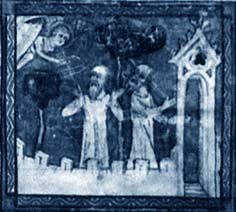Written by Derek
A. Olsen:
derekolsen@apocalyptic-theories.com

the five
sections are present![]() .
The scroll fragments and writing can be dated to the first half of the
second century
.
The scroll fragments and writing can be dated to the first half of the
second century![]() .
Thus, it was in existence in the late second century BCE. As the Qumran
fragments reveal, the book's original language was Aramaic and its provenance
was Palestine. Greek fragments also survive but the book is found in its
entirety only in Ethiopic.
.
Thus, it was in existence in the late second century BCE. As the Qumran
fragments reveal, the book's original language was Aramaic and its provenance
was Palestine. Greek fragments also survive but the book is found in its
entirety only in Ethiopic.
The large
number of fragments at Qumran suggest that it held canonical status there
and it was quoted in the community's documents. Of particular interest
to the sectarians was the astronomical section which upheld a solar calendar
over the lunisolar calendar used by the Temple hierarchy in Jerusalem.
The book appears to have had wide circulation within Jewish apocalyptic
groups including Christianity; Jude 1:14 cites it as authoritative Scripture.
The Epistle of Barnabas also quotes it and some of the early Church Fathers
like Tertullian approved of it. It fell into disfavor after the fourth
century and is only preserved in the Ethiopian Orthodox Church which still
regards it as canonical. This work had little direct influence on medieval
Christianity except where it influenced the New Testament itself and the
thought-world of the early Church![]() .
.
| Continued |